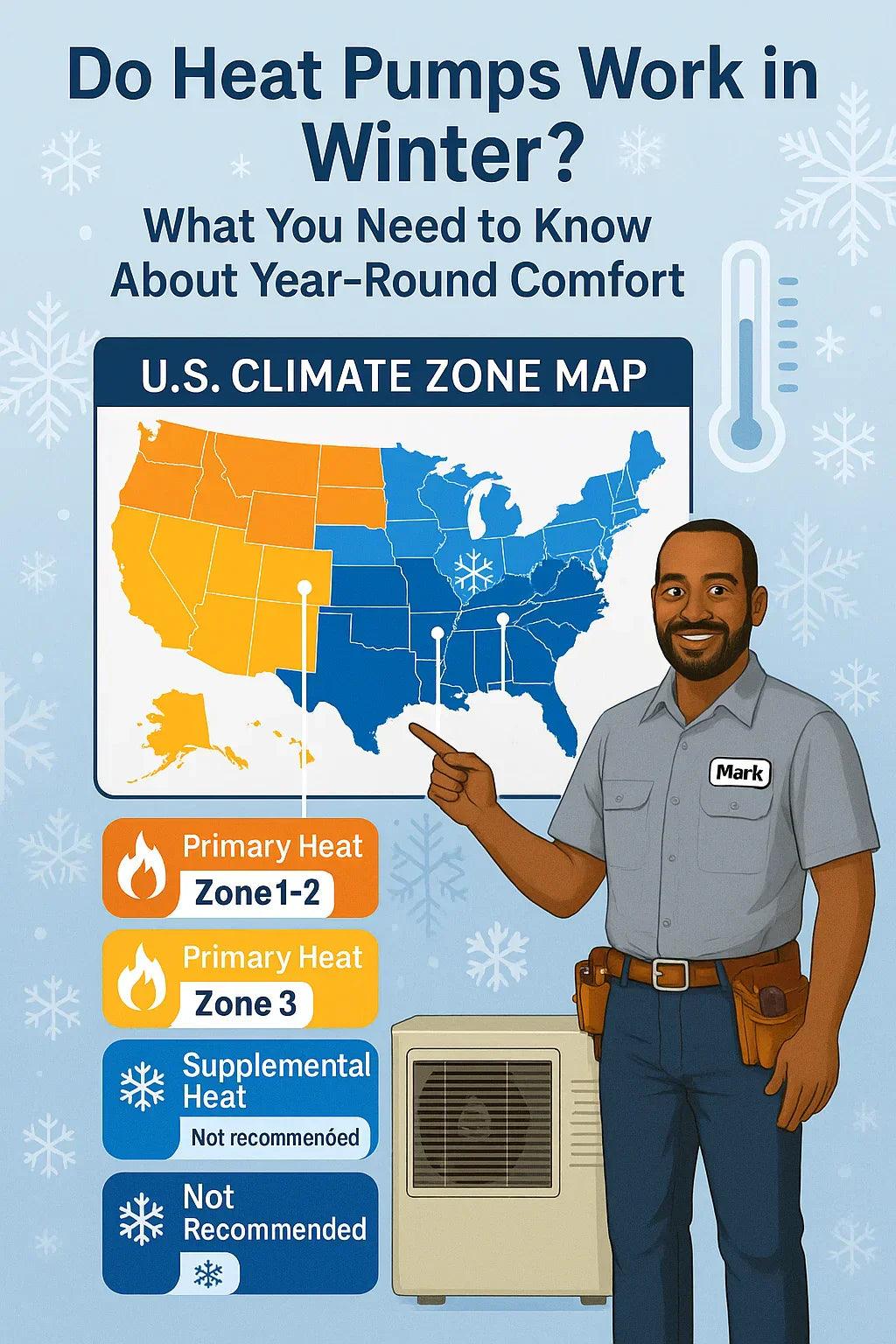🏠 Introduction: Can a Heat Pump Keep You Warm When It’s Cold Out?
You’ve chosen the Amana 9,300 BTU Through-the-Wall Air Conditioner with Heat Pump for its compact design and dual-purpose functionality. But as winter rolls around, you might be wondering:
“Will this heat pump actually work when it’s freezing outside?”
For homeowners like Mark, who want year-round comfort without central HVAC, this is a valid and critical question. Through-the-wall units with heat pumps are convenient and efficient, but they’re not all built for deep cold.
This article explains:
-
How heat pumps work in winter
-
Where they perform best
-
What happens when the temperature drops
-
How the Amana unit stacks up
-
What you can do to maximize winter performance
🔁 1. How Heat Pumps Work in Heating Mode
🔄 Reverse the Flow
Unlike furnaces that generate heat by combustion or resistance, heat pumps work by transferring heat. In winter, the system pulls heat from outdoor air and moves it inside, even when it’s cold outside.
Even at 30°F, there’s still thermal energy in the air—your heat pump extracts it.
⚡ Efficiency Wins
The biggest advantage: heat pumps use electricity much more efficiently than space heaters.
-
A baseboard heater has a COP (Coefficient of Performance) of ~1.0 (1 unit of heat per 1 unit of energy)
-
Heat pumps can have a COP of 2.0–3.5, depending on outdoor temps
🔗 U.S. Department of Energy – How Heat Pumps Work
❄️ 2. What Happens When the Temperature Drops?
🌡️ Efficiency Declines with Temperature
Heat pumps perform best in mild to moderate cold. As the outdoor temperature drops, it becomes harder to extract heat — and efficiency goes down.
| Outdoor Temp | Typical COP |
|---|---|
| 60°F | 3.5 |
| 40°F | 2.8 |
| 30°F | 2.1 |
| 20°F | ~1.3 |
| 10°F or below | <1.0 (backup needed) |
Once the temperature drops below the unit’s balance point (usually 30–35°F for wall units), it may struggle to maintain set temperatures, and the electric resistance backup—if equipped—kicks in.
🚫 When It’s Too Cold
-
At below 20°F, many through-the-wall heat pumps become ineffective
-
The unit may shut down heating mode or struggle to deliver meaningful warmth
🔗 Energy Star – Cold Climate Heat Pump Performance
🗺️ 3. Performance by Climate Zone: Can You Rely on It?
The U.S. Department of Energy divides the country into climate zones. Your zone matters when deciding if a heat pump can provide primary heat or should be supplemental only.
| Zone | Region Example | Winter Use for Amana Unit |
|---|---|---|
| 1–2 | FL, TX, Southern CA | ✅ Primary heat is fine |
| 3 | NC, TN, parts of OK | ✅ Primary or backup heating |
| 4 | PA, IL, KS | ⚠️ Use as supplemental heat |
| 5+ | MN, ME, Northern NY | ❌ Needs backup system |
📉 4. Heat Pump vs. Baseboard vs. Gas Furnace in Winter
Here’s how different systems compare in terms of cost and efficiency:
| System | COP / Efficiency | Cost per 10,000 BTUs (avg) | Ideal Use |
|---|---|---|---|
| Heat Pump (mild) | 2.5–3.5 COP | $0.10–$0.15 | Primary or supplemental |
| Baseboard Heat | 1.0 COP | $0.30–$0.35 | Supplemental only |
| Gas Furnace | ~95% AFUE | $0.12–$0.18 | Primary heating system |
In mild climates, the Amana’s heat pump costs about half as much to run as an electric space heater.
🔗 NREL – Space Heating Technology Comparison
🧊 5. How the Amana 9,200 BTU Unit Performs in Winter
🧪 Manufacturer Specs:
-
Heating capacity: ~8,000 BTUs
-
COP: ~3.1 (at 47°F), declines with temp
-
Max Efficiency Range: 40°F and up
-
Minimum Operating Temp: ~20–25°F
✅ Real-World Application:
Mark lives in Tennessee (Zone 3b). Winters are mostly in the 30s–40s.
The Amana unit:
-
Works well as primary heat in bedrooms or home offices
-
May need support (like a space heater) on rare sub-20°F nights
⚠️ If you’re in a Zone 4 or 5 region:
-
Expect reduced heating power below freezing
-
Use the Amana unit as supplemental heating (not your only source)
🧰 6. Winter Heat Pump Tips for Maximum Comfort
🧼 1. Keep the Filter Clean
-
Dirty filters = reduced airflow and reduced heating efficiency
🪟 2. Seal Windows & Doors
-
Drafty windows can easily offset your heating gains
-
Use thermal curtains, caulk, and weatherstripping
🎛️ 3. Use a Programmable Thermostat
-
Avoid frequent temperature swings
-
Maintain a steady target (68–70°F recommended)
🧯 4. Have a Backup Plan
-
For regions where temps drop below 25°F:
-
Keep a small electric heater as emergency backup
-
Consider an in-wall electric heater for redundancy
-
🔗 Energy Saver: Heat Pump Maintenance Tips
✅ 7. Is a Wall Heat Pump Enough for You?
Use It As Primary Heat If:
-
You live in Zones 1–3
-
Your room is well-insulated
-
You don’t need to heat a large open-concept space
Use It As Supplemental Heat If:
-
You live in Zones 4–5
-
You already have a furnace or baseboard
-
You need to warm an enclosed porch, office, or basement
❌ Avoid for Sole Heat If:
-
You’re expecting sub-20°F temperatures frequently
-
The room is drafty or poorly insulated
-
The space is over 400 sq ft with high ceilings
🧠 Mark’s Take
“I’m in Kentucky, and my Amana unit handles my office just fine in the winter — down to the high 20s. When it gets below that, I plug in a space heater for a boost. It’s great 90% of the time and saves me money compared to running baseboard heat.”
In the next topic we will know more about: What’s the Best Wall Sleeve for Your Amana AC? Compatibility, Fit & Installation Tips







